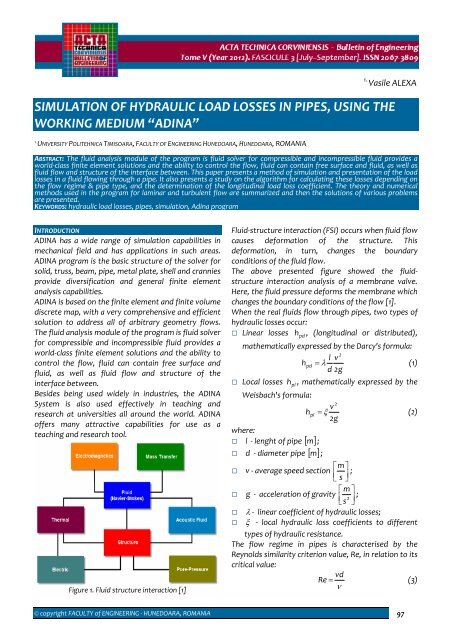1 - Acta Technica Corviniensis
1 - Acta Technica Corviniensis
1 - Acta Technica Corviniensis
You also want an ePaper? Increase the reach of your titles
YUMPU automatically turns print PDFs into web optimized ePapers that Google loves.
1.Vasile ALEXASIMULATION OF HYDRAULIC LOAD LOSSES IN PIPES, USING THEWORKING MEDIUM “ADINA”1.UNIVERSITY POLITEHNICA TIMISOARA, FACULTY OF ENGINEERING HUNEDOARA, HUNEDOARA, ROMANIAABSTRACT: The fluid analysis module of the program is fluid solver for compressible and incompressible fluid provides aworld‐class finite element solutions and the ability to control the flow, fluid can contain free surface and fluid, as well asfluid flow and structure of the interface between. This paper presents a method of simulation and presentation of the loadlosses in a fluid flowing through a pipe. It also presents a study on the algorithm for calculating these losses depending onthe flow regime & pipe type, and the determination of the longitudinal load loss coefficient. The theory and numericalmethods used in the program for laminar and turbulent flow are summarized and then the solutions of various problemsare presented.KEYWORDS: hydraulic load losses, pipes, simulation, Adina programINTRODUCTIONADINA has a wide range of simulation capabilities inmechanical field and has applications in such areas.ADINA program is the basic structure of the solver forsolid, truss, beam, pipe, metal plate, shell and cranniesprovide diversification and general finite elementanalysis capabilities.ADINA is based on the finite element and finite volumediscrete map, with a very comprehensive and efficientsolution to address all of arbitrary geometry flows.The fluid analysis module of the program is fluid solverfor compressible and incompressible fluid provides aworld‐class finite element solutions and the ability tocontrol the flow, fluid can contain free surface andfluid, as well as fluid flow and structure of theinterface between.Besides being used widely in industries, the ADINASystem is also used effectively in teaching andresearch at universities all around the world. ADINAoffers many attractive capabilities for use as ateaching and research tool.Figure 1. Fluid structure interaction [1]Fluid‐structure interaction (FSI) occurs when fluid flowcauses deformation of the structure. Thisdeformation, in turn, changes the boundaryconditions of the fluid flow.The above presented figure showed the fluidstructureinteraction analysis of a membrane valve.Here, the fluid pressure deforms the membrane whichchanges the boundary conditions of the flow [1].When the real fluids flow through pipes, two types ofhydraulic losses occur: Linear losses h pd , (longitudinal or distributed),mathematically expressed by the Darcy's formula:2l vhpd= λ(1)d 2g Local losses h pl , mathematically expressed by theWeisbach's formula:2vhpl= ξ(2)2gwhere:m ; l ‐ lenght of pipe [ ] d ‐ diameter pipe [ m; ]⎡m ⎤ v ‐ average speed section⎢⎣ s ⎥ ;⎦⎡ m ⎤ g ‐ acceleration of gravity⎢ 2⎣s⎥ ;⎦ λ ‐ linear coefficient of hydraulic losses; ξ ‐ local hydraulic loss coefficients to differenttypes of hydraulic resistance.The flow regime in pipes is characterised by theReynolds similarity criterion value, Re, in relation to itscritical value:vdRe = (3)ν© copyright FACULTY of ENGINEERING ‐ HUNEDOARA, ROMANIA 97
















